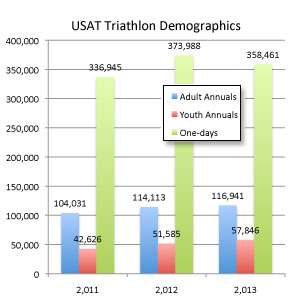Why U.S. Women Rock
Have you noticed that the United States does better in women’s Olympic-style triathlon than in men’s? The U.S. may be the best so far, as a nation, in women’s Olympic-format triathlon since the turn of the century. Why is that?
Former elite runner Greg Hitchcock wrote on Slowtwitch back in 2001 about certain benchmark achievements in high school running in America, per decade. He noted that high schoolers who broke 4:10 for the mile or 9-minutes for 2 miles peaked in the 1970s, then declined in the 80s, more so in the 90s, and only started to rise in the 2000s. These high quality performances have risen since Greg wrote that article, bolstering Greg’s point that high quality running performances mirror population trends.
Greg’s point was this: If you want to get the girls, go out for football. That’s the glamour sport if you’re a teenager. As a general rule, those who go out for cross country are too small or frail or slow afoot to make the football team. The football team always fills up its roster first. The leftovers go out for cross country (a no-cut sport). Accordingly, the population only has to go up or down a little bit to make a big difference in how many people go out for cross country.

The chart above shows just trends, and is flattened to show categories at once, on the same graph. The line in blue shows the total number of 18 and 19 year olds in school in the U.S. during each decade. Obviously that number is orders of magnitude higher than participation in any high school sport. To give a sense of scale, in 1983 if you added boys and girls cross country and swimming, that combined total was only 45 percent of the total number of boys participation in 11-man high school football. (But in 2013 endurance sport participation is 70 percent of the football total, the increase mostly – but not entirely – due to the huge upsurge in girls swimming and XC.) The point of the chart above is to show generally what happened in the high school population overall, and how that tracks with participation in football, cross country and swimming. As the population of 18 and 19 year olds dipped nationwide, football dipped a bit, but boys XC and swimming suffered significantly.
Why did this happen? If you exclude other Fall sports like soccer, tennis and water polo, let us say there are 100 boys available for football and cross country. If the freshman and varsity football teams suck up 80 boys, you have 20 left over for XC. If the population of high school boys decreases by 10 percent, assuming the football team continues to fill its rosters, you just whacked the cross country team by half.
This isn't precisely what happened, but in broad strokes this is the paradigm we saw in high school athletics as a function of nationwide demographics and birth rates over the past 40 years. In the 20-year period between 1973 and 1993 the population of 18 and 19 year olds in the U.S. fell by 14 percent according to the U.S. Census. Participation in football fell somewhat less than that amount, while boys cross country participation decreased by 32 percent over that time, almost triple the decrease in boys football. Maybe cross country became out of vogue. Maybe it was cannibalized by newer, hotter sports, like soccer.
But if you look at the population rebound, from 1993 to 2013, we see that Americans aged 18 and 19 increased by 28 percent during that time. Football participation increased during that time by 12 percent, which makes sense, because football squads can't grow with the population — once squads are full they're full. You can only increase participation if you open new high schools or if you increase the size of the squad. However, during that same time span boys cross country increased by a whopping 77 percent (so much for the notion cross country lost its appeal!). It becomes clear that the level of football participation rises and falls at or less than the rise and fall of the overall high school population, but changes in the high school age census creates huge swings in cross country participation.
Maybe this explains in part the running boom of the late 70s and 80s. As high schoolers matriculated they were more inclined and better prepared to enter footraces, since the cross country squads throughout the 80s were well populated. Likewise the running boom of the past decade, as the number of high schoolers running cross country over the past dozen years has skyrocketed.

But the real boom as been in women’s participation, and not just in cross country, but in swimming. If you look at the chart above, can you see why the number of boys high quality distance achievements were high in the 1970s, dipped in the 80s, dipped more in the 90s, and rebounded in the aughts? This chart shows what happened to boys participation and it roughly mirrors – in trend if not in magnitude – the population of high school students. You’ll see the same in boy’s swimming. But look what happened to the girls numbers, both in swimming and in XC. They shot skyward, to the point where now you have many more girls than boys in high school swim programs.
I think this explains in large part why America’s women are, as a group, since 2000, at a consistently higher level than mens. Our men are good, they’re just not better than those in other countries, and it could be argued (it’s what I argue) that our men are at a disadvantage because the path of our good athletes is to enter college out of high school and focus on a single sport. Much of the rest of the world does not have that attachment to college straight out of high school, allowing promising triathletes to focus on triathlon full time at a much earlier age. This isn’t a criticism of America’s system, rather a statement of its values.
America’s women follow that same path. What they do have that many other countries don’t is the ability to be swimmers and runners in focused, structured, enclaved programs as early as their freshman years in high school. They not only have that ability, they’ve availed themselves of it. in 1973 girls’ participation in cross country and swimming was only 26 percent of boys’ participation. Ten years later than number had shot up to 70 percent. The latest data, which is a year or two old, shows that female participation in cross country and swimming is 97.7 percent of the boys total. When the latest participation numbers are released this might be the year when girls participation in cross country and swimming combined passes the combined participation of boys in those two sports.
This is also a hopeful sign for the future of sports like triathlon in the age group ranks. We have now reached a point where boys and girls participation in high school cross country and swimming are all at all-time highs, and this has not been the case until recently. Only in 2006 did we see boys participation in cross country reach the level it enjoyed in the early to mid 1970s. Only in 2009 did boys swimming reach the level it enjoyed in the mid-70s. If the heyday of high school participation in endurance sports preceded triathlon’s original upsurge beginning in 1980, perhaps those just now exiting college as well as those getting ready to enter it – young men and women – presage another golden era in triathlon, both at the elite and enthusiast level.
The date for the above figures and graphs came from the U.S. Census Bureau, the U.S. Department of Education's National Center for Education Statistics and the National Federation of State High School Associations.





